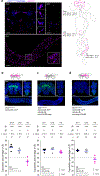A nutrient-specific gut hormone arbitrates between courtship and feeding
- PMID: 35140404
- PMCID: PMC9271372
- DOI: 10.1038/s41586-022-04408-7
A nutrient-specific gut hormone arbitrates between courtship and feeding
Abstract
Animals must set behavioural priority in a context-dependent manner and switch from one behaviour to another at the appropriate moment1-3. Here we probe the molecular and neuronal mechanisms that orchestrate the transition from feeding to courtship in Drosophila melanogaster. We find that feeding is prioritized over courtship in starved males, and the consumption of protein-rich food rapidly reverses this order within a few minutes. At the molecular level, a gut-derived, nutrient-specific neuropeptide hormone-Diuretic hormone 31 (Dh31)-propels a switch from feeding to courtship. We further address the underlying kinetics with calcium imaging experiments. Amino acids from food acutely activate Dh31+ enteroendocrine cells in the gut, increasing Dh31 levels in the circulation. In addition, three-photon functional imaging of intact flies shows that optogenetic stimulation of Dh31+ enteroendocrine cells rapidly excites a subset of brain neurons that express Dh31 receptor (Dh31R). Gut-derived Dh31 excites the brain neurons through the circulatory system within a few minutes, in line with the speed of the feeding-courtship behavioural switch. At the circuit level, there are two distinct populations of Dh31R+ neurons in the brain, with one population inhibiting feeding through allatostatin-C and the other promoting courtship through corazonin. Together, our findings illustrate a mechanism by which the consumption of protein-rich food triggers the release of a gut hormone, which in turn prioritizes courtship over feeding through two parallel pathways.
© 2022. The Author(s), under exclusive licence to Springer Nature Limited.
Conflict of interest statement
DECLARATION OF INTERESTS
The authors declare no competing interests.
Figures













Similar articles
-
Peristalsis in the junction region of the Drosophila larval midgut is modulated by DH31 expressing enteroendocrine cells.BMC Physiol. 2010 Aug 10;10:14. doi: 10.1186/1472-6793-10-14. BMC Physiol. 2010. PMID: 20698983 Free PMC article.
-
A neuronal mechanism controlling the choice between feeding and sexual behaviors in Drosophila.Curr Biol. 2021 Oct 11;31(19):4231-4245.e4. doi: 10.1016/j.cub.2021.07.029. Epub 2021 Aug 5. Curr Biol. 2021. PMID: 34358444 Free PMC article.
-
Calcitonin gene-related peptide neurons mediate sleep-specific circadian output in Drosophila.Curr Biol. 2014 Nov 17;24(22):2652-64. doi: 10.1016/j.cub.2014.09.077. Epub 2014 Oct 30. Curr Biol. 2014. PMID: 25455031 Free PMC article.
-
Courtship behavior in Drosophila melanogaster: towards a 'courtship connectome'.Curr Opin Neurobiol. 2013 Feb;23(1):76-83. doi: 10.1016/j.conb.2012.09.002. Epub 2012 Sep 28. Curr Opin Neurobiol. 2013. PMID: 23021897 Free PMC article. Review.
-
Conditioned courtship suppression in Drosophila melanogaster.J Neurogenet. 2021 Sep;35(3):154-167. doi: 10.1080/01677063.2021.1873323. Epub 2021 Jan 31. J Neurogenet. 2021. PMID: 33522326 Review.
Cited by
-
Neural Control of Action Selection Among Innate Behaviors.Neurosci Bull. 2022 Dec;38(12):1541-1558. doi: 10.1007/s12264-022-00886-x. Epub 2022 May 28. Neurosci Bull. 2022. PMID: 35633465 Free PMC article. Review.
-
The role of diuretic hormones (DHs) and their receptors in Drosophila.BMB Rep. 2023 Apr;56(4):209-215. doi: 10.5483/BMBRep.2023-0021. BMB Rep. 2023. PMID: 36977606 Free PMC article. Review.
-
Dietary regulation in health and disease.Signal Transduct Target Ther. 2022 Jul 23;7(1):252. doi: 10.1038/s41392-022-01104-w. Signal Transduct Target Ther. 2022. PMID: 35871218 Free PMC article. Review.
-
Synaptic connectome of a neurosecretory network in the Drosophila brain.bioRxiv [Preprint]. 2024 Aug 29:2024.08.28.609616. doi: 10.1101/2024.08.28.609616. bioRxiv. 2024. PMID: 39257829 Free PMC article. Preprint.
-
High-resolution comparative single-cell transcriptomics of doublesex-expressing neurons reveals evolutionary conservation and diversity of sexual circuits in Drosophila.bioRxiv [Preprint]. 2025 May 10:2025.05.06.652433. doi: 10.1101/2025.05.06.652433. bioRxiv. 2025. PMID: 40654601 Free PMC article. Preprint.
References
-
- Tinbergen N The Study of Instinct. (Clarendon Press, 1951).
-
- McFarland DJ Decision making in animals. Nature 269, 15–21 (1977).
-
- Stearns SC The Evolution of Life Histories. (OUP Oxford, 1992).
-
- Roff D Evolution Of Life Histories: Theory and Analysis. (Springer US, 1993).
-
- Sutton AK & Krashes MJ Integrating Hunger with Rival Motivations. Trends Endocrinol. Metab 31, 495–507 (2020). - PubMed
Publication types
MeSH terms
Substances
Grants and funding
LinkOut - more resources
Full Text Sources
Molecular Biology Databases

